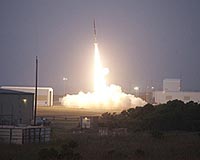 |
for Astrobiology Magazine Moffett Field CA (SPX) Jul 10, 2009 A transparent roundworm could reveal the biological effects of microgravity and space radiation, and perhaps provide clues on how to protect future human astronauts headed for the moon, Mars and beyond. The C. elegans worm's biological responses proved eerily similar to those of humans during a series of experiments aboard the International Space Station in 2004. Now researchers have published a review of their findings in the journal Advances in Space Research. "At least at face value, this validates that you can use C. elegans to look at mechanisms of muscle atrophy in spaceflight," said Nathaniel Szewczyk, a biomedical researcher at the University of Nottingham in the UK and member of the research team. Szewczyk said that the worms allow researchers to study both radiation and muscle health problems facing human astronauts, which remain poorly understood. Researchers could even launch the worms on unmanned missions to future human destinations such as Mars, and remotely study the effects of long-term spaceflight.
Why muscles get weaker "Rate of synthesis is down across all species [in spaceflight]," Szewczyk explained. "It doesn't matter if you're a worm, rat or human." C. elegans already represents a model organism for study among biologists, along with other creatures such as the Drosophila fly. So it was an obvious choice when researchers from Canada, France, Japan and the United States decided to combine forces for the International C. elegans Experiment, also known as ICE-FIRST. A Russian Soyuz spacecraft launched 53 specimens to the space station in 2004. A matching set of roundworms stayed on Earth to act as the lab control. ICE-FIRST showed a connection between weakened muscles and a reduced amount of a gene transcription factor which helps manufacture new muscle proteins. The transcription factor changes could in turn come from disruptions further up the molecular command chain, such as altered Insulin or TGF-beta signaling during spaceflight. This strongly suggests that spaceflight affects the usual gene transcription process in which new proteins are made. However, researchers can't confirm a cause until they run more experiments where they actively block the transcription process to produce weakened muscles. Besides, spaceflight may not only affect new muscle creation - it might also degrade or weaken existing muscle. There's less evidence for this, but it's a main focus for Szewczyk. He wants to continue studying how typical muscle degradation occurs on Earth, and also use future space experiments to examine the activity of enzymes called proteases, which degrade proteins. Other space experiments done by the Japanese and Chinese space agencies have since replicated and confirmed the muscle atrophy results from ICE-FIRST.
A living radiation dosimeter The roundworms showed that they could normally repair their radiation damaged cells in spaceflight by using apoptosis, or the programmed cell death which can also be triggered by unusual amounts of damage. Researchers say that this makes them ideal "living dosimeters" to track accumulated radiation damage over time. Since ICE-FIRST, another space station experiment successfully tested a fully automated culturing system which maintained the roundworms for six months without human intervention. That could pave the way for future radiation studies. "With the radiation aspect, there's the idea of automating experiments and putting them on unmanned platform," Szewczyk explained. "We could actually put worms on an unmanned mission to Mars." Still, a shift toward human rather than animal spaceflight experiments has squeezed the C. elegans studies. The original NASA program under which ICE-FIRST operated has been cancelled, although the U.S. space agency may once again be looking for "model organism" experiments, Szewczyk noted. So just as flies and monkeys once preceded man's first step into an unknown space environment, perhaps creatures such as C. elegans could once again blaze a path to more distant planetary bodies in the solar system. Share This Article With Planet Earth
Related Links University of Nottingham Space Tourism, Space Transport and Space Exploration News
 Rocket Launch Helps Prepare MSU Faculty For Training Students
Rocket Launch Helps Prepare MSU Faculty For Training StudentsBozeman MT (SPX) Jul 03, 2009 Three Montana State University instructors who want to help future scientists and engineers develop experiments for space recently launched experiments of their own. During a weeklong RockOn/RockSat workshop in Virginia, Ross Snider, Randy Larimer and Angela Des Jardins joined nearly 100 university instructors and students from 21 states who prepared experiments for flight. A rocket ... read more |
|
| The content herein, unless otherwise known to be public domain, are Copyright 1995-2009 - SpaceDaily. AFP and UPI Wire Stories are copyright Agence France-Presse and United Press International. ESA Portal Reports are copyright European Space Agency. All NASA sourced material is public domain. Additional copyrights may apply in whole or part to other bona fide parties. Advertising does not imply endorsement,agreement or approval of any opinions, statements or information provided by SpaceDaily on any Web page published or hosted by SpaceDaily. Privacy Statement |